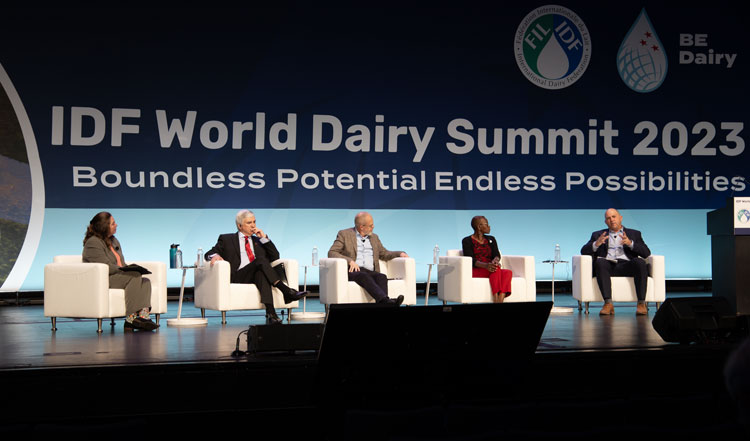
Even though their farms lie on four different continents, the four dairy farmers who shared the stage to talk about their businesses during the World Dairy Summit shared a similar vision: their vocation provides an opportunity to move their communities and the world forward. That attitude was summarized by Margaret Munene, who works with hundreds of smallholder dairy farmers in Kenya: “A cow is never a problem. It is always a solution.”
For Steen Madsen, a dairyman in Denmark, the opportunity for solving problems is in the area of environmental stewardship and sustainability. Having a milk buyer in the future relies on dairy farmers proving they are taking care of the resources they are stewarding, he believes.
Madsen explained that farmers in his country can earn rewards for different sustainability efforts they implement. Feed efficiency, fertilizer use, land use, protein efficiency, and animal robustness are the top five areas that are evaluated, he continued. In his co-op, Arla Foods, reduced carbon dioxide emissions earn them an extra premium in their milk check just like milk quality and animal welfare standards do.
Farmers make conservation efforts every day, but there needs to be a clear system if farmers are to receive support for that work like Arla provides. “We need to document it and explain it in a way that is understood by politicians and consumers,” Madsen described. “Sustainability will give us the opportunity to continue farming.”
Eduardo Schwerter, a third-generation dairy farmer in Chile, added that sustainability is a three-legged stool that must remain balanced between environmental, social, and economic factors. Chile has dealt with dairy farm consolidation in recent years, but milk production is rising and dairy consumption is strong. There is still lots of opportunity for the industry to grow, he shared.
“Milk will always be needed,” Schwerter said in describing that the social component of dairying is what motivates him. It is good that our consumers have been empowered to choose their food, he added. That just means we need to make sure we are communicating with them to showcase the work we are doing.
California dairy farmer Simon Vander Woude believes dairy can become the product of choice for consumers. To him, sustaining a market means producing milk efficiently, and his dairies have done that by embracing a number of technologies. For one, they heavily use genomic testing as well as beef semen to reduce the number of animals they raise. Today, Vander Woude said, they have 0.64 heifers on their farm for every milking cow.
They have also found success with renewable energy. Solar panels provide much of the electricity for his 6,000-cow farm, and they installed an anaerobic digester on their home farm that 14 other nearby dairies also bring manure to.
“We will always be open to the next opportunity to do a better job,” said Vander Woude.
Not every solution will work for every farm, but that attitude is one all panelists agreed with. Finding ways to sell a better product while using less and contributing to the physical, social, and environmental health of their communities is what matters to these farmers and all farmers doing this job around the world.








